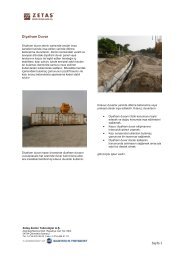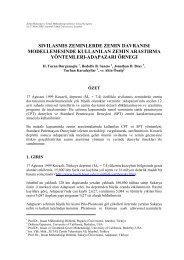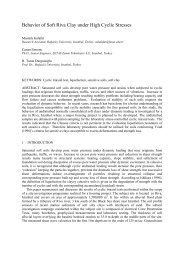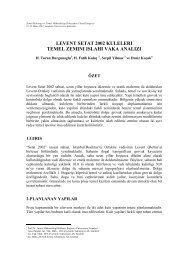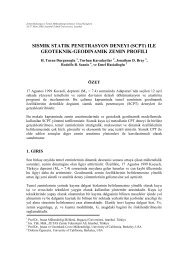Ozsoy, M.B., Durgunoglu, H.T.(2003)
Ozsoy, M.B., Durgunoglu, H.T.(2003)
Ozsoy, M.B., Durgunoglu, H.T.(2003)
Create successful ePaper yourself
Turn your PDF publications into a flip-book with our unique Google optimized e-Paper software.
An assessment of the liquefaction susceptibility of Adapazari siltR.B. Sancio, J. D. Bray & M.F. RiemerUniversity of California, Berkeley, USA.T. <strong>Durgunoglu</strong>Bogazici University, Istanbul, Turkey.ABSTRACT: Liquefaction and cyclic softening of fine-grained soils occurred inAdapazari during the 1999 Kocaeli, Turkey earthquake. The results of a large number ofcyclic triaxial tests performed on "undisturbed" specimens of silty and clayey soilsobtained from throughout the city are discussed. The tests show that the current state-ofthe-artmethod for the determination of liquefaction susceptibility of fine-grained soils,i.e. the Chinese criteria, is not reliable. Soils that liquefied often met the liquid limit andliquidity index conditions of the Chinese criteria, but did not typically meet the clay-sizecondition. Test results do not show a marked effect of soil plasticity on cyclic strength ofsoils with (N 1 ) 60 < 10 when PI < 12. However, soils with PI > 20 tested at effectiveconfining stresses < 50 kPa did not generate significant strain after the application of alarge number of loading cycles.1 INTRODUCTIONThe strong shaking produced by the 1999 Kocaeli earthquake caused widespread damage throughoutthe northwest region of Turkey. Hundreds of buildings in Adapazari, an industrial city locatedapproximately 120 km east of Istanbul, and about 7 km north from the fault rupture, were severelydamaged. Additionally, areas of extensive ground failure occurred as evidenced by buildingsettlement, sliding, and tilting. Many of the affected buildings had sand boils in their vicinity,although often ejecta were not present. The soils underlying the buildings that experienced groundfailure were found to be primarily fine-grained (Bray et al. 2001).The use of state-of-the-art methods for screening and identification of potentially liquefiable soils (asdefined by the recent consensus paper by Youd et al., 2001) in Adapazari did not identify theproblematic soils without modifying the commonly accepted “Chinese criteria” for fine-grained soils(Sancio et al., 2002). This observation generated the need for testing “undisturbed” soil specimensretrieved from sites where surface manifestations of ground failure were observed to establish thethreshold, if any, for liquefaction triggering of plastic and non-plastic fine-grained soils.2 SCREENING AND IDENTIFICATION OF LIQUEFIABLE SOILSIn recent years much research has been devoted to understanding the liquefaction susceptibility offine-grained soils. Due to space limitations, only a limited review of relevant studies is presented.Based on the data from sites where liquefaction was and was not observed after earthquakes in China,Wang (1979) established that any clayey soil containing less than 15% to 20% particles by weightsmaller than 5 µm and water content (w c ) to liquid limit (LL) ratio greater than 0.9 is susceptible toliquefaction. Based on these data, Seed and Idriss (1982) stated that clayey soils (i.e. plots above theA-line on the plasticity chart) could be susceptible to liquefaction only if all three of the followingconditions are met: (1) Percent less than 5 µm < 15%, (2) LL < 35, and (3) w c /LL > 0.9. Due to itsPaper Number 172
origin, this standard is known in the literature as the “Chinese criteria.”Koester (1992) noted that the determination of LL by means of the fall cone used in China producedvalues that are about 4 points higher than those values determined by means of the Casagrandepercussion device. Hence, Koester recommended a slight reduction of the LL condition of theChinese criteria before using it as a screening tool when the Casagrande method has been used.Similarly, Andrews and Martin (2000) reduced the LL condition for liquefaction susceptibility to < 32.Andrews and Martin then used 2µm as the limit between silt-size and clay-size particles, with < 10%clay-size particles being necessary for a silty or clayey soil to be liquefiable. Moreover, Andrews andMartin dropped the w c /LL ratio as a condition in their liquefaction susceptibility criteria of silty soils.After the 1989 Loma Prieta earthquake, Boulanger et al. (1998) noted that a deposit of clayey soilmight have contributed to the surface deformations observed at the Moss Landing site. Theyconcluded that indiscriminate use of the Chinese criteria as a substitute for detailed laboratory and insitutesting should be avoided. Similarly, Perlea (2000) recommends laboratory testing as the bestway to evaluate the liquefaction susceptibility and post-cyclic undrained strength of cohesive soils.The location of a soil on the Casagrande plasticity chart and, or in combination with, the use of the "C"descriptor of the Unified Soil Classification System (USCS) have also been introduced as a tool toidentify potentially liquefiable soils. Youd (1998) recommends the Chinese criteria as a generallyconservative predictive tool. Additionally, he follows a series of assumptions to state that natural soildeposits that have a "C" descriptor (e.g. CH, CL, SC, and GC) are screened as nonliquefiable. Possiblyliquefiable fine-grained soils should have LL < 35 and plot below the A-line or have PI < 7. Seed etal. (2001) indicate that soils that have LL < 30 and PI < 10 are liquefiable, and those with 30 < LL
3.2 Testing equipmentAll tests in this study were performed using the Automated Triaxial Testing System (Li et al. 1988) inthe geotechnical laboratory of ZETAS Corporation in Istanbul, Turkey. This testing system is amodification and extension of the CKC electropneumatic cyclic triaxial testing system described byChan (1982). The instrumentation of this equipment includes five sensors: an external load cell andexternal LVDT to monitor the axial load and vertical displacement, respectively and three differentialpressure transducers to measure the chamber pressure, the effective stress, and the volume change.The system is controlled by a computer through the Georobot software (v. 5.2), and allows closed-loopstress controlled cyclic loading at low frequencies, and open-loop control at 1 Hz.A series of cyclic triaxial tests were first performed on Monterey sand following the methodologydescribed by Silver et al. (1976), and the testing equipment and procedure were shown to produceresults consistent with those previously published.3.3 Specimen preparation and testing procedureTrimming was avoided to minimize disturbance. However, the upper 5 to 10 cm of soil that wasdisturbed due to drilling was removed, and similarly, 5 to 10 cm of soil was removed from the bottomend of the tube. The sampling tubes were fixed onto the circular vice of a vertical extruder and cut atthe desired length using a rotating tube cutter. The length was chosen so that the sample would have aheight to width ratio between 2.1 and 2.5. To avoid radial deformation of the tube and possibledisturbance to the soil during the cutting operation, two stiffening rings were placed above and belowthe location of the cut. Additionally, the tube cutter was turned slowly while applying gentle pressure.There was no visual evidence of reduction in diameter due to inward folding of the edges of the tube.The burrs produced by the cut were removed from the top end of the tube prior to extrusion.The soil was pushed upwards in the same direction of movement during sampling. The upper portionof the exposed sample that was damaged during the deburring operation was removed using a wiresaw. Once the desired length had been extruded the specimen was cut at the bottom using a wire sawand carefully placed over the bottom platen of the triaxial cell. Capillary stresses in these fine-grainedsoils were sufficient to temporarily maintain freestanding specimens. The top platen was set over thespecimen and a 0.3 mm-thick latex membrane was placed around the specimen using a membranestretcher. The membrane was sealed to the platens with O-rings, the top drainage line was connectedand a small vacuum was applied to provide confinement. The value of the vacuum depended on theconfining pressure at which the specimen would be tested and was equal to 30 kPa for tests atconfining pressures greater than 40 kPa, and 15 kPa otherwise.After the applied vacuum had consolidated the specimen, its height was measured with a dial gaugeand its diameter at the bottom, center, and top using a Pi tape. The average of the three diametermeasurements was used for the computation of the effective diameter. Comparison of heightmeasurements performed on a large number of specimens before and after the application of the initialvacuum show small variations in height (ε < 0.5%). The triaxial cell was then fully assembled and thechamber was filled with water. Sample saturation using differential vacuum was performed using theprocedure described by Riemer et al. (1999) and followed by a new height measurement andinstallation into the triaxial testing equipment for backpressure saturation and cyclic loading. Duringconsolidation of the specimens to the initial confining stress, the volumetric strain was monitored andfound to be < 1%. According to the criteria used at the NGI for the assessment of specimen quality(Andresen and Kolstad, 1979), a test specimen is "very good to excellent" when the volume changedue to consolidation to in-situ conditions is < 1%.The soil specimens were saturated at isotropic confining stresses (σ' bp ) slightly smaller than the finalconsolidation stress, σ' c (e.g. σ' bp = 30 kPa, for σ' bp = 40 kPa) to avoid exceeding σ' c during B-valuemeasurements. For all cases, B > 0.98 was achieved at relatively low backpressures (< 150 kPa), andall measurements were performed with a stress increment of 50 kPa.Following saturation and consolidation to the desired confining stress, the cyclic test was performed3
y applying stress controlled sinusoidal loading under undrained conditions at a frequency of typically1 Hz. The loading amplitude was characterized in terms of the Cyclic Stress Ratio (CSR), which forthe triaxial test is defined as the maximum peak shear stress divided by the initial effectiveconsolidation stress, σ' c . In general, one of three nominal CSRs (0.3, 0.4, and 0.5) was applied to agiven specimen. The cyclic loading was applied until axial strains in excess of 4% were achieved.Figure 1 presents typical results for a cyclic test performed on non-plastic silt.q (kPa)6040200-20-40-60-5 -4 -3 -2 -1 0 1 2 3 4 5Axial Strain (%)0 10 20 30 40 50 60p' (kPa)Figure 1 Typical results of an undrained cyclic triaxial test on non-plastic silt (LL = 23). Thistest was performed at σ' c = 50 kPa and CSR = 0.48.4 TESTING PROGRAM AND DISCUSSION OF TEST RESULTSThe primary objective of the testing program was to understand the causes of ground failure observedat building sites in Adapazari after the Kocaeli earthquake given that the in-situ tests showed that thefoundation soils were predominantly silts and clays. Of interest was the fact that ground failure wasprevalent adjacent to structures and less observed away from them (Bray et al. 2001).The natural variability of the soil conditions in Adapazari allowed studying the effect of variousfactors, such as initial confining stress, plasticity, frequency of loading, and initial shear stress on thecyclic strength of silts, clayey silts, and clays. Overall, 100 cyclic triaxial tests and 20 static tests wereperformed on "undisturbed" soil specimens recovered at 7 different sites throughout the city. Figure2a presents the location on the plasticity chart of the specimens tested under cyclic triaxial conditions,and Figure 2b depicts the relationship between the LL and water content for these soils. Tests wereperformed on soils with a wide variety of properties that cover a large range on the plasticity scale (0 0.8. In thispaper only the effect of soil plasticity and initial confining stress will be discussed for specimenstested under initial isotropic conditions using uniform cyclic loads at a frequency of 1 Hz.The calculation and comparison of the effective stress path (q vs. p') in the 1 Hz and 0.005 Hz cyclictests provided evidence of the limitations of the measurements of pore water pressure changes onclayey silts and clays during a 1 Hz cyclic triaxial test. For this reason, it is unclear if these soils reacha state of zero effective stress during undrained cyclic loading at 1 Hz. In this study, the results ofparticular tests will be presented in terms of the number of uniform stress cycles necessary to reach3% single amplitude (compression or extension) axial strain. Results are similar if the 5% doubleamplitude axial strain criterion is used.4
Plastic Limit5040302010Liquid Limit806040LL = w c /0.8LL = w c /0.900 10 20 30 40 50 60 70 80Liquid Limit2020 30 40 50Moisture ContentFigure 2 (a) Location on the Casagrande plasticity chart of the soils tested in this study, (b) relationshipbetween the LL and moisture content of the soils.4.1 Effect of plasticity index on the cyclic strengthThe effect of soil plasticity was studied by comparing the results of specimens of different plasticitytested at the same confining stress. Figure 3a and 3b present the results of tests performed at σ' c = 40and 50 kPa, respectively. A distinction of the cyclic strength for soil specimens with PI ≤ 12 could notbe discerned, and the results are therefore grouped in two categories, soils with PI ≤ 12 and soils with12 < PI < 20. It is worth mentioning that most of the data from sites that liquefied in China on whichthe Chinese criteria (Wang, 1979) is based, have PI < 12 and w c /LL > 0.85. Additionally, this issomewhat consistent with Ishihara (1996), who defines PI = 10 as the boundary after which acorrection factor greater than one should be applied to the cyclic strength of soils as determined fromin-situ methods. However, different from our results, Ishihara suggests the application of linearlyincreasing correction factors to soils with 10 < PI < 55. In this study, specimens with PI > 20, and inparticular when w c /LL < 0.8, did not generate significant cyclic strains after a large number of cycleshad been applied at low initial confining stress (σ' c < 50 kPa).0.60.512 20 did not generate significant pore pressures or axial strain.The void ratio of the 26 specimens with PI ≤ 12 shown in Figure 3 ranges between 0.75 and 1.00, andon average e = 0.86. Given that the specimens tested are not of identical soils, it is difficult to assessthe effect of density in terms of void ratio. However, the scatter of the data, particularly at 50 kPa, issufficiently small to indicate that the possible effect of density on the cyclic resistance of the soil isnegligible or compensated by another effect when the results are grouped in terms of PI. The5
normalized penetration resistances, (N 1 ) 60 , in terms of the Standard Penetration Test (SPT) performedon the soil deposits tested in this study are consistently lower than 10.4.2 Effect of initial isotropic confining stressTo assess the effect of the weight of the structure on the cyclic strength of the soil, a series of tests wasperformed at different initial isotropic stresses. Liquefaction analysis presented by Sancio et al. (2002)using state-of-the-art procedures delineated by Youd et al. (2001) show that the majority of the weaksoil deposits at the sites of interest lie at depths generally between 2 and 5 m and have (N 1 ) 60 < 10.This considered, a value of σ' c = 25 kPa was chosen as representative of depths between 2 and 5 m inthe free-field. Similarly, 40 kPa and 50 kPa were estimated as representative of the mean effectivestress for soils under the corner of the mat foundation of typical 4 to 5 story structures in Adapazari.Additionally, a series of tests was performed on soils consolidated to 100 and 300 kPa.The number of uniform stress cycles necessary to reach 3% single amplitude axial strain vs. theresultant CSR are shown in Figure 4a for specimens with PI ≤ 12 and (N 1 ) 60 < 10. The proportionalityof strength to initial confining stress can be noted from these results. From Figure 4b it is observedthat in terms of CSR at 20 uniform cycles, specimens tested at σ' c = 25 kPa are approximately 200%stronger than those tested at 100 kPa, and about 150% stronger than specimens tested at 40 to 50 kPa.The resulting K σ correction factor, which results from the ratio of the CSR at a given confining stressby the CSR for σ' c = 100 kPa at 20 cycles of loading, is presented in Figure 4b. As shown, the valuesobtained for the Adapazari soils with PI ≤ 12 is consistent with that recommended by Youd et al.(2001) for stress > 50 kPa when a value of f = 0.7 is used.CSR0.60.50.425 kPa40 kPa50 kPa75 kPa100 kPa300 kPaK σ2.22.01.81.61.41.2This studyYoud et al. 2001K σ = (σ' v /Pa) f-1f = 0.70.31.00.80.20.61 10 100 1000Number of Cycles to 3% Axial Strain0 50 100 150 200 250 300Mean effective confining stress (kPa)Figure 4 (a) Cyclic stress ratio (CSR) vs. number of cycles to reach 3% single amplitude axial strain forspecimens of PI < 12 and (N 1 ) 60 < 10, tested at 25, 40, 50, 75, 100 and 300 kPa, and (b) resulting confiningpressure effect.4.3 Evaluation of the Chinese criteriaFigure 5 has been developed to evaluate the effectiveness of the Chinese criteria in the evaluation ofthe liquefaction susceptibility of the specimens tested whose results are shown in Figures 3 and 4. InFigures 4a and 4b, circles are used to depict the properties of soils with PI ≤ 12, squares are used forsoils with 12 < PI < 20, and triangles represent soils with PI > 20. If the Chinese criteria had beenused, only about a fourth of the specimens (closed circles) would meet all three conditions.Conversely, all but four specimens of soil with PI ≤ 12 meet the LL and w c /LL conditions of theChinese criteria. Of these, two specimens do not meet the w c /LL condition, and two others do notmeet the LL condition, yet they still liquefied in the cyclic triaxial testing at a reasonable number ofloading cycles. None of the soils with PI > 12 meet all three conditions of the Chinese criteria. Theseresults indicate that the amount of particles smaller than the 5 or 2µm condition, is a poor indicator ofliquefaction susceptibility of soils and should not be used.6
7070Liquid Limit6050403020SusceptibleNotSusceptible0 10 20 30 40 50 60 70Percent weight corresponding to 5µmFigure 5 Graphical representation of the Chinese criteria. Specimens with PI ≤ 12 are shown as circles,specimens with 12 < PI < 20 as squares, and triangles represent soils with PI > 20. Filled in circlescorrespond to specimens that meet all three conditions of the Chinese criteria.Liquid Limit6050403020NotSusceptible`Susceptible20 30 40 50Moisture Content5 CONCLUSIONSBased on a large number of cyclic triaxial tests performed on "undisturbed" specimens of Adapazarisilt and silty clay of low penetration resistance [(N 1 ) 60 < 10], the following conclusions are drawn:1. The Chinese criteria is not effective for the evaluation of liquefaction susceptibility of fine grainedsoils with PI ≤ 12, due primarily to the ineffectiveness of the condition on the amount of particlessmaller the 5µm. Additionally, this testing program has shown that soils with PI > 12, whichgenerally have LL > 35, can generate significant strains in a small number of cycles when a highCSR is applied.2. Plasticity Index in combination with w c /LL appear to be good indicators of soil liquefactionsusceptibility. Fine grained soils from Adapazari with PI ≤ 12 and w c /LL > 0.8 are susceptible toliquefaction, and soils of 12 < PI < 20 and w c /LL > 0.8 should be tested in the laboratory to assesstheir liquefaction susceptibility.3. A limited number of tests that were performed on specimens with PI > 20 with w c /LL < 0.8, didnot generate significant cyclic strains after a large number of cycles had been applied at initialconfining stresses < 50 kPa.4. The fact that ground failure in Adapazari was primarily observed adjacent to buildings may beattributed to, among other factors, the detrimental effect of an increase in confining stress on thecyclic strength when represented in terms of the cyclic stress ratio.5. This testing program has shown that limiting K σ ≤ 1.0 may be overly conservative at lowconfining stress.6 ACKNOWLEDGEMENTSFinancial support for the testing program presented herein was provided by the National ScienceFoundation under Grant CMS-011606. ZETAS Corporation provided the laboratory equipment andfacilities in Istanbul, as well as the drilling and sampling equipment in Adapazari. Other support suchas housing was provided by ZETAS Corporation and our Turkish colleagues, and this and all supportis greatly appreciated.REFERENCES:Andresen, A.A. & Kolstad P., 1979. The NGI 54-mm samplers for undisturbed sampling of clays andrepresentative sampling of coarser materials. Proc. of the Intl. Sym. on Soil Sampling. Singapore, 1979, 13-7
21.Andrews D.C.A., & Martin G.R., 2000. Criteria for liquefaction of silty soils. Proc. of the 12th world Conf. onEarthquake Engineering, Auckland, NZ. Paper 0312.Boulanger R.W., Meyers M.W., Mejia L.H. & Idriss I.M. 1998. Behavior of a fine-grained soil during the LomaPrieta earthquake. Canadian Geotechnical Journal, Vol 35, 146-158.Bray J.D., Sancio R.B., <strong>Durgunoglu</strong> H.T., Onalp A., Seed R.B., Stewart J.P., Youd T.L., Baturay M.B., CetinK.O., Christensen C., Karadayilar T. & Emrem C., 2001b. Ground failure in Adapazari, Turkey. 15thInternational Conference on Soil Mechanics and Geotechnical Engineering, TC4 satellite conference on"Lessons learned from recent strong earthquakes". Istanbul, TurkeyChan C.K., 1982. An electropneumatic cyclic loading system. Geotechnical Testing Journal, Vol. 4(4): 183-187Koester J.P., 1992. The influence of test procedure on correlation of Atterberg limits with liquefaction in finegrainedsoils. Geotechnical Testing Journal, Vol. 15(4): 352-361.Hvorslev M.J., 1949. Subsurface exploration and sampling of soils for civil engineering purposes. WaterwaysExperiment Station, Vicksburg, Mississippi.Ishihara, K., 1996. Soil behaviour in earthquake geotechnics. The Oxford engineering science series. No. 46.Li X.S., Chan C.K. & Shen C.K., 1988. An Automated Triaxial Testing System. In Advanced Triaxial Testing ofSoil and Rock; American Society for Testing and Materials, Philadelphia, 1988. 95-106.Perlea V. G., 2000. Liquefaction of cohesive soils. In Soil Dynamics and Liquefaction 2000. The 2000 specialtyconference, Denver CO. ASCE geotechnical special publication No. 107: 58-75Polito C., 2001. Plasticity based liquefaction criteria. Proceedings of the 4th international conference on recentadvances in geotechnical earthquake engineering and soil dynamics. Paper No. 1.33.Riemer M.F., Houston W. & Chan C.K., 1999. Advanced geotechnical laboratory testing - techniques andprocedures for the measurement of soil properties. CE 270L class reader. University of California, Berkeley.Sancio R.B., Bray J.D., Stewart J.P., Youd T.L., <strong>Durgunoglu</strong> H.T., Onalp A., Seed R.B., Christensen C., BaturayM.B., & Karadayilar T., 2002. Correlation between ground failure and soil conditions in Adapazari, Turkey.Soil Dynamics and Earthquake Engineering. In press.Seed H.B. & Idriss I.M., 1982. Ground motions and soil liquefaction during earthquakes. EERI Monograph,Berkeley, California.Seed R.B., Cetin, K.O. & Moss R.E.S., 2001. Recent advances in soil liquefaction hazard assessment. 15thinternational conference on soil mechanics and geotechnical engineering, TC4 satellite conference on"Lessons learned from recent strong earthquakes". Istanbul, TurkeySilver M.L., Chan C.K., Ladd R.S., Lee K.L., Tiedemann D.A., Townsend F.C., Valera J.E & Wilson J.H., 1976.Cyclic triaxial strength of standard test sand. Journal of the Geotechnical Engineering Division. Vol.102(GT5): 511-523.Wang W., 1979. Some findings in soil liquefaction. Water Conservancy and Hydroelectric Power ScientificResearch Institute, Beijing, China.Youd T.L., 1998. Screening guide for rapid assessment of liquefaction hazard at highway bridge sites.Multidisciplinary Center for Earthquake Engineering, technical report MCEER-98-0005, June.Youd T.L., Idriss I.M., Andrus R.D., Arango I., Castro G., Christian J.T., Dobry R., Finn W.D.L., Harder Jr.L.F., Hynes M.E., Ishihara K., Koester J.P., Liao S.S.C., Marcuson III W.F., Martin G.R., Mitchell J.K.,Moriwaki Y., Power M.S., Robertson P.K., Seed R.B., & Stokoe II K.H., 2001. Liquefaction resistance ofsoils: summary report from the 1996 NCEER and 1998 NCEER/NSF workshops on evaluation of liquefactionresistance of soils. Journal of Geotechnical and Geoenvironmental Engineering. Vol. 127(10): 817-903.8



